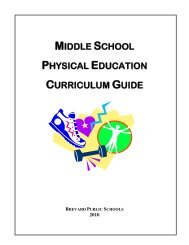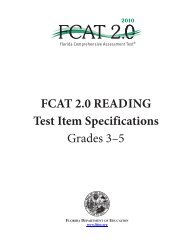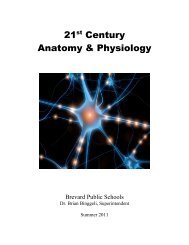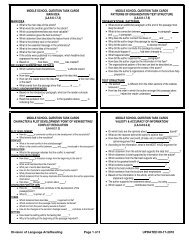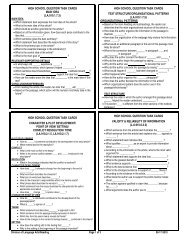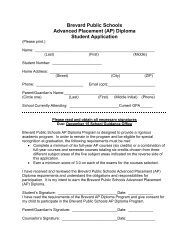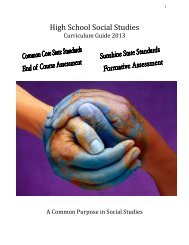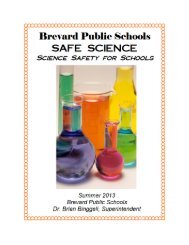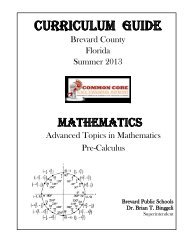Science Research Program Guide - Secondary Programs Home ...
Science Research Program Guide - Secondary Programs Home ...
Science Research Program Guide - Secondary Programs Home ...
Create successful ePaper yourself
Turn your PDF publications into a flip-book with our unique Google optimized e-Paper software.
� Potentially Hazardous Biological Agents �<br />
(includes rules involving microrganisms, rDNA, and human and vertebrate animal tissues)<br />
Projects involving microorganisms (including bacteria, viruses, 7) <strong>Research</strong> determined to be a Biosafety Level 2 (BSL-2)<br />
viroids, prions, rickettsia, fungi, and parasites), recombinant<br />
MUST be conducted in a laboratory rated BSL-2 or above<br />
DNA (rDNA) technologies or human or animal fresh/frozen<br />
(commonly found in a regulated research institution). The<br />
tissues, blood, or body fluids may involve working with<br />
research must be reviewed and approved by the<br />
potentially hazardous biological agents. Students are permitted Institutional Biosafety Committee (IBC) or a letter obtained<br />
to do research projects with potentially hazardous biological<br />
from an institutional representative that the research does<br />
agents as long as every effort is made to ensure that they work<br />
not require review. The research must be supervised by a<br />
safely and that the projects meet the conditions and rules<br />
Qualified Scientist. The student researcher must receive<br />
described below. The following rules were developed to protect extensive training, demonstrate competency and be directly<br />
students and to help them adhere to federal and international<br />
supervised while conducting microbiological procedures.<br />
biosafety regulations and guidelines.<br />
8) <strong>Research</strong> determined to be biosafety levels 3 or 4 is<br />
When dealing with potentially hazardous biological agents it is prohibited for precollege students.<br />
the responsibility of the student and all of the adults involved in 9) Studies intended to produce or genetically engineer<br />
a research project to conduct and document a risk assessment bacteria with multiple antibiotic resistance are prohibited.<br />
to define the potential level of harm, injury or disease to plants, Extreme caution should be exercised when selecting out<br />
animals and humans that may occur when working with<br />
antibiotic resistant organisms. Studies using such<br />
biological agents. The risk assessment determines a final<br />
organisms require at least BSL-2 containment.<br />
biosafety level which then determines the laboratory facilities, 10) All potentially hazardous biological agents must be properly<br />
equipment, training, and supervision required for the research<br />
disposed of at the end of experimentation in accordance<br />
project to proceed. See page 23.<br />
with their biosafety level. Following are acceptable<br />
All projects involving microorganisms, recombinant DNA<br />
technologies and human or animal fresh/frozen tissues, blood or<br />
body fluids must adhere to the rules below AND, depending on<br />
the study, to the additional rules in Section A, B or C.<br />
Rules for ALL Studies Involving<br />
procedures for disposal of cultured materials: Autoclaving<br />
at 121 degrees Celsius for 20 minutes, use of 10% sodium<br />
hypochlorite, incineration, alkaline hydrolysis, and biosafety<br />
pick-up.<br />
11) Studies involving the culturing of human or animal waste,<br />
including sewage sludge, must be treated as a BSL-2 study.<br />
Potentially Hazardous Biological Agents 12) The following types of studies are exempt from prior SRC<br />
1) The use of potentially hazardous microorganisms (including<br />
bacteria, viruses, viroids, prions, rickettsia, fungi, and<br />
parasites), recombinant DNA (rDNA) technologies or human<br />
or animal fresh/frozen tissues, blood, or body fluids is<br />
allowable under the conditions and rules that follow. All of<br />
these areas of research may involve potentially hazardous<br />
biological agents and require special precautions.<br />
2) An appropriate review and approval committee (SRC, IBC,<br />
IACUC) must approve all research before experimentation<br />
begins. The initial risk assessment determined by the student<br />
researcher and adults supervising the project must be<br />
confirmed by the SRC.<br />
3) Experimentation involving culturing of potentially hazardous<br />
biological agents, even BSL-1 organisms, is prohibited in a<br />
home environment. However, specimens are allowed to be<br />
collected at home as long as they are immediately transported<br />
to a laboratory with the appropriate level of biosafety<br />
containment.<br />
4) Naturally-occuring plant pathogens may be studied (not<br />
cultured) at home, but may not be introduced into a home/<br />
review<br />
A. No additional forms required:<br />
1) Studies involving baker’s yeast and brewer’s yeast,<br />
except when involved with rDNA studies<br />
2) Commercially-available coliform water test kits<br />
3) Studies involving Lactobacillus, Bacillus thurgensis,<br />
nitrogen-fixing, oil-eating bacteria and algae-eating<br />
bacteria introduced into their natural environment. (Not<br />
exempt if cultured in a petri dish environment that could<br />
potentially be contaminated).<br />
B. Require completed Risk Assessment Form 3:<br />
1) Studies involving protists, archae and similar<br />
microorganisms<br />
2) <strong>Research</strong> using manure for composting or other nonculturing<br />
experiments and fuel production.<br />
13) Any proposed changes in the Student Checklist (1A) and<br />
<strong>Research</strong> Plan by the student after initial SRC approval<br />
must have subsequent SRC or IBC review and approval<br />
before such changes are made and before experimentation<br />
resumes.<br />
garden environment.<br />
14) The following forms are required:<br />
5) A risk assessment must be conducted by the student and<br />
adult supervisors prior to experimentation and a final<br />
biosafety level must be determined or confirmed by the SRC.<br />
See page 23.<br />
6) <strong>Research</strong> determined to be at Biosafety Level 1(BSL-1) may<br />
be conducted in a BSL-1 or higher laboratory. The research<br />
must be supervised by a Qualified Scientist or a trained<br />
Designated Supervisor. The student must be properly trained<br />
in standard microbiological practices.<br />
a.<br />
b.<br />
c.<br />
d.<br />
e.<br />
f.<br />
Checklist for Adult Sponsor (1), Student Checklist<br />
(1A), <strong>Research</strong> Plan, and Approval Form (1B)<br />
Regulated <strong>Research</strong> Institution Form (1C) - if appl.<br />
Qualified Scientist (2), if applicable<br />
Risk Assessment (3), if applicable<br />
PHBA Risk Assessment Form (6A)<br />
Human and Vertebrate Animal Tissue Form (6B) – for<br />
all studies involving tissues and body fluids.<br />
International Rules for Precollege <strong>Science</strong> <strong>Research</strong>: <strong>Guide</strong>lines for <strong>Science</strong> and Engineering Fairs / 2008-2009 Page 21



